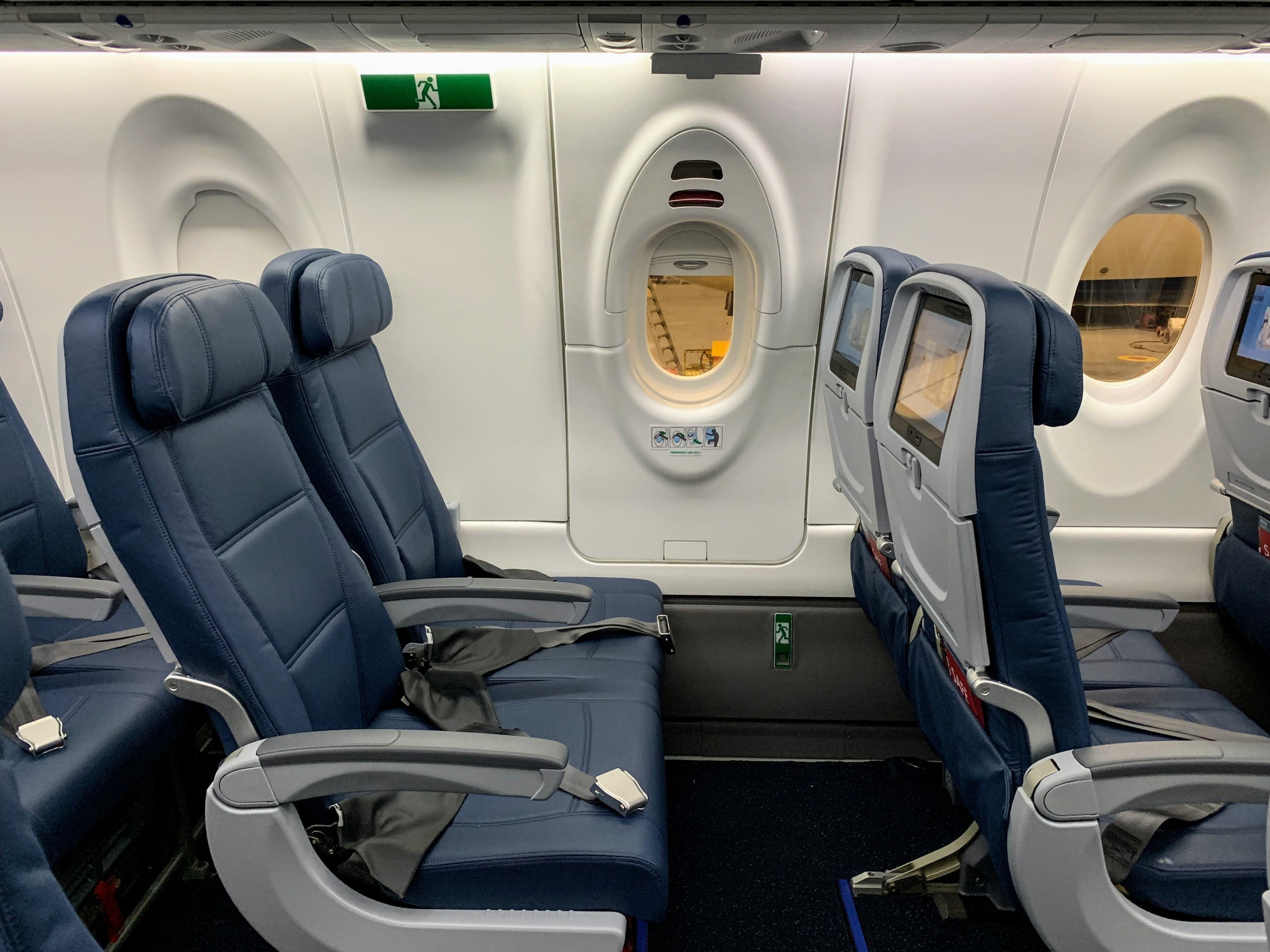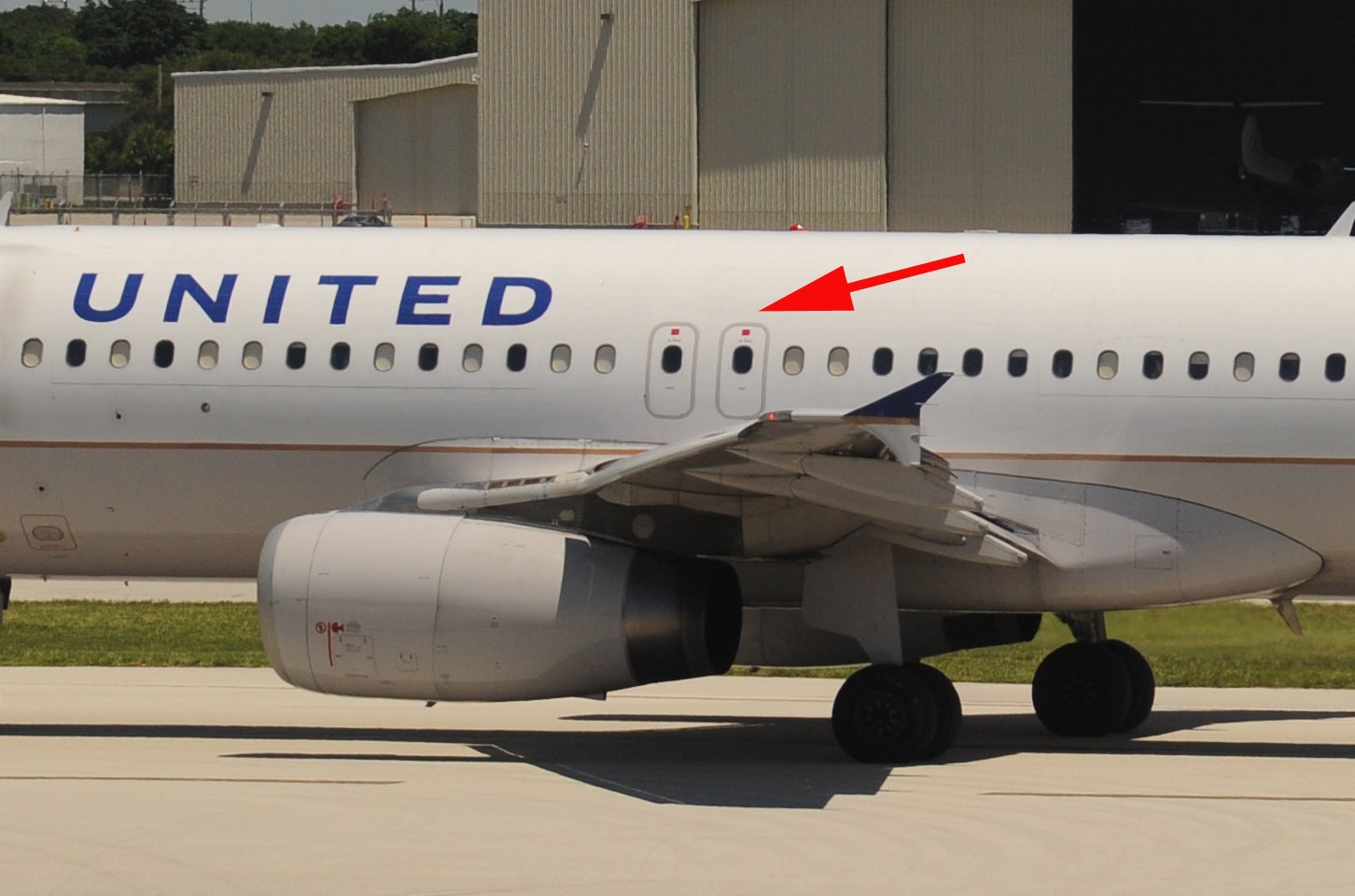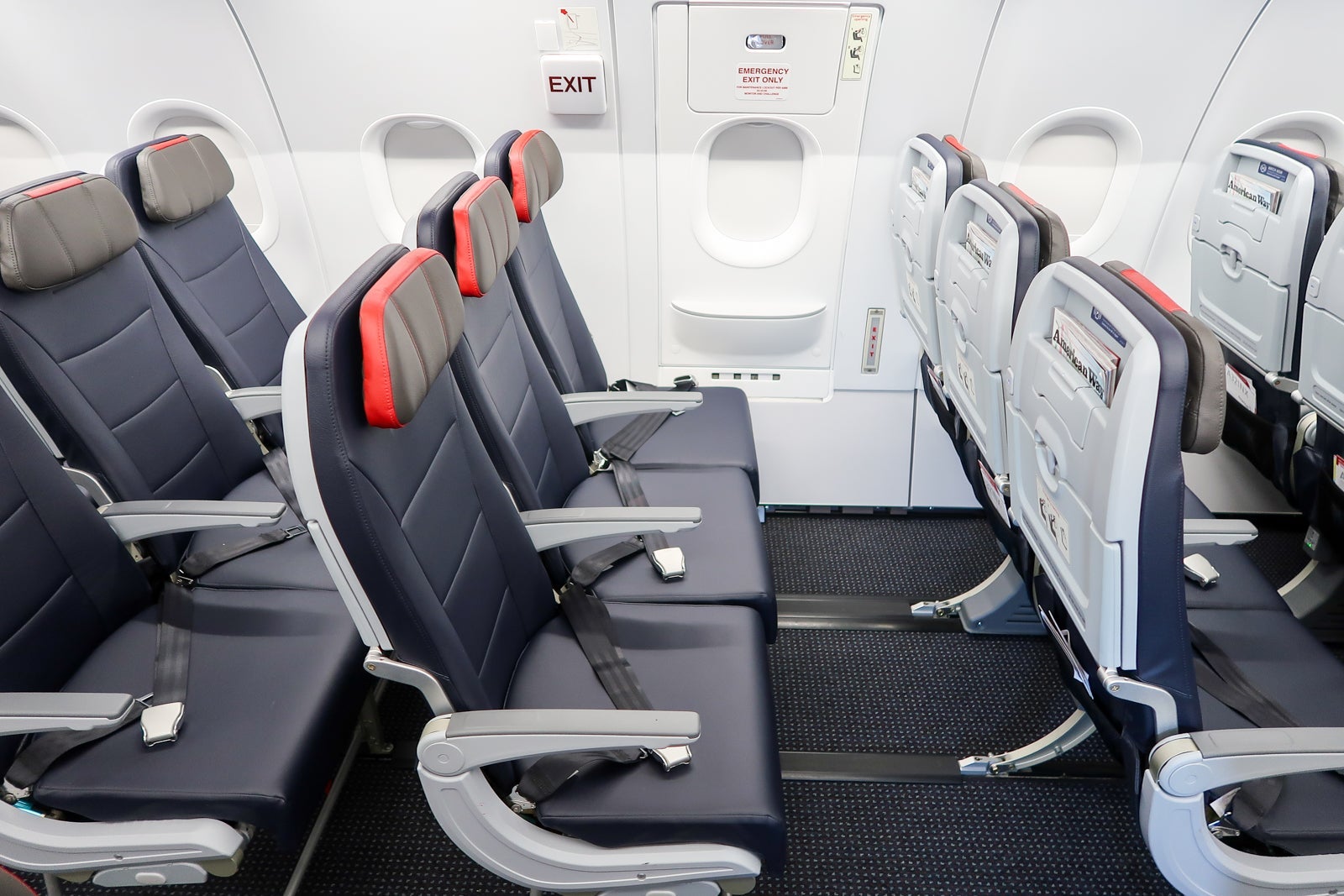Here's Why You Might Not Be Allowed To Fly in The Exit Row
Seats in the exit row are among the most coveted seats on an airplane. Featuring extra legroom and in some cases limitless legroom, they are known as the most valuable real estate in coach class to frequent flyers. Airlines are also well aware of how valuable these seats are to flyers, often charging hundreds of dollars on longer international flights for them. While exit-row seating is reserved for elite frequent flyers and passengers willing to pay for the extra legroom, snagging these seats isn't a guarantee that you'll be allowed to sit in the exit row. Here's why.
If you've ever sat in the exit row, you're probably familiar with the pre-departure exit-row briefing. Flight attendants are required by law to brief any passenger seated there prior to departure. Though we don't like to imagine a scenario in which we are actually called upon to operate the emergency exit, it can happen.
The responsibility as a passenger seated in the exit row cannot be understated. Countless incidents show just how important it is that passengers are able to operate the emergency exits. For this reason, the Federal Aviation Administration and other regulatory bodies have implemented a fairly extensive list of restrictions on who can and cannot sit in the exit row.
Here Is What Will Keep You From Sitting in The Exit Row
Technically, if a flight attendant deems you unfit to operate the emergency exit, you are required by law to forfeit your seat in the exit row. The degree to which those restrictions are enforced is entirely up to the flight crew. So, if you've managed to get away with breaking one of these restrictions in the past, there's no guarantee that the flight attendants on your next flight will allow you to sit in the exit row.
The following requirements and restrictions for passengers seated in the emergency exit rows come directly from the Federal Aviation Administration:
1. "The person lacks sufficient mobility, strength, or dexterity in both arms and hands, and both legs."
The first FAA-mandated requirement for occupants of the emergency exit rows is straightforward. If you lack the strength or dexterity to operate the emergency exits, you won't be allowed to sit in the exit row. On many aircraft, the emergency exit hatch at overwing exits can weigh upwards of 40 pounds and require quite some dexterity to open.

If a flight attendant was to notice a passenger seated in the exit row struggling to store their luggage in the overhead bin or having difficulty reaching their assigned seat, these observations could disqualify them from the exit row.
2. "The person is less than 15 years of age or lacks the capacity to perform one or more of the applicable functions without the assistance of an adult companion, parent, or other relative."
Flight attendants will ultimately make the decision on whether or not to ask a passenger about their age. If a passenger under the age of 15 is erroneously sat in the exit row, they will be relocated.
I personally have been reseated when I was traveling as a young teenager. However, at other times, my age was not questioned and I was allowed to occupy the exit row.

3. "The person lacks the ability to read and understand instructions required by this section and related to emergency evacuation provided by the certificate holder in printed or graphic form or the ability to understand oral crew commands."
In the United States, this requirement means that all passengers seated in the exit row must be able to understand and speak English. In countries where English is not the primary or official language, passengers will be required to understand the language spoken in that country. Essentially, all passengers seated in the emergency exit rows need to be able to comprehend all oral, visual, and written commands or instructions.
This is one of the reasons flight attendants are required to receive a verbal yes from passengers seated in the exit row. This verbal response allows flights attendants to determine whether or not a passenger can understand what the flight attendant is saying and can articulate a logical response.
4/5. "The person lacks sufficient visual capacity to perform one or more of the applicable functions without the assistance of visual aids beyond contact lenses or eyeglasses. The person lacks sufficient aural capacity to hear and understand instructions shouted by flight attendants, without assistance beyond a hearing aid."
Passengers seated in the exit row must be able to see and hear clearly. The first step in operating the emergency exit row is to observe conditions outside of the passenger cabin.
Additionally, upon landing or ditching, flight attendants give verbal commands to passengers seated in the exit row. If a passenger is unable to hear these commands, they will be unable to determine whether or not to open the emergency exit.
If you wear glasses, contacts, or a hearing aid, you do not have to worry. The FAA allows passengers who wear corrective eyewear or hearing aids to sit in the emergency exit row.
6. "The person lacks the ability adequately to impart information orally to other passengers."
Passengers seated in the emergency exit row are on the front lines of an emergency evacuation. It's important that they are able to articulate directions to other passengers. This is also one of the reasons flight attendants ask passengers seated in the emergency exit row to give a verbal yes.
7. "The person has a condition or responsibilities, such as caring for small children, that might prevent the person from performing one or more of the applicable functions or a condition that might cause the person harm if he or she performs one or more of the applicable functions."
If a passenger seated in the exit row is found to be traveling with children seated elsewhere in the cabin, flight attendants might ask that passenger to relocate to another seat. In the event of an emergency, passengers operating the emergency exit row are required to devote their full and undivided attention to the evacuation procedures.
Finally, if a passenger has a condition that would result in injury should they be called upon to operate the emergency exit, they are unable to sit in the emergency exit row. Conditions include physical injury, mental health complications, or other preexisting health conditions.

Additional Restrictions on Exit Row Seating
In addition to the restrictions mandated by the FAA and other regulatory agencies, individual airlines have expanded on these somewhat broad restrictions by clarifying certain scenarios. The scenarios include the use of temporary medical devices, passengers of size, seatbelt extension use, and traveling with cabin pets.
Passengers of Size and Seatbelt Extenders
While passengers of size are not expressly prohibited from sitting the exit row, if a passenger's size requires them to preboard or use a seatbelt extender at any time during the flight, they will not be allowed to sit in the exit row.
This restriction was implemented for two reasons. The first reason (and the reason cited by airlines) is to prevent obstruction of the emergency exits. Seatbelt extensions can obstruct the emergency exits. Seatbelt extensions potentially become entangled in the seatbelts of nearby passengers, become snagged on nearby objects, or create a tripping hazard for passengers evacuating the aircraft.
The second reason passengers requiring additional assistance or seatbelt extensions due to their size cannot be seated in the exit row is due to decreased mobility.
Expecting Mothers
If a passenger seated in the exit row is pregnant they are, by law, required to be reseated.
Passengers Requiring Portable Oxygen Concentrators
Again, this is for two reasons. First, the use of a portable oxygen concentrator to breathe normally can be considered a medical condition. Second, the tubes found on portable oxygen devices and the device itself can obstruct the emergency exit or inhibit the operation of the emergency exits.
Passengers Traveling With a Cabin Pet
All cabin pets are required to be placed in an airline-compliant carry-on container. This container, along with the cabin pet, must be stored underneath the seat in front of you at all times during the flight. A cabin pet and the carrier could obstruct the emergency exit row.
What If The Only Seat Left is In The Exit Row?
Per federal regulations, if the only remaining seat on a flight is in an emergency exit row and a passenger does not meet the exit seat requirements, they will be involuntarily denied boarding or carriage. It's an unfortunate reality, but no exceptions can be made with regards to exit row seating.
In most cases, a fellow passenger will likely give up their seat elsewhere in the cabin, allowing a passenger prohibited from sitting in the exit row to travel. However, there aren't regulations that would force a passenger to give up their seat to accommodate another passenger.
Bottom Line
Ultimately, whether or not a passenger is fit to sit in the emergency exit row will be determined by the flight attendant. Flight attendants are required by law to conduct all emergency exit row duties in a non-discriminatory fashion. Though it might be embarrassing or seem discriminatory, demanding that a passenger move from a more desirable seat because they require a seatbelt extender or have a medical condition is completely legal. If you are asked to vacate your comfy seat in the exit row, it's important to understand just how critical the emergency exits are in an evacuation.
If you are unsure of the exit seat requirements and restrictions of an individual airline, most airlines provide detailed information on their website.
TPG featured card
Rewards
| 2X miles | 2 miles per dollar on every purchase |
| 5X miles | 5 miles per dollar on flights and vacation rentals booked through Capital One Business Travel |
| 10X miles | 10 miles per dollar on hotels and rental cars booked through Capital One Business Travel |
Intro offer
Annual Fee
Recommended Credit
Why We Chose It
The Capital One Venture X Business Card has all the Capital One Venture X Rewards Credit Card has to offer and more. It offers an incredible welcome bonus and requires an equally impressive spend to qualify. In addition, the card comes with premium travel perks like annual travel credit. (Partner offer)Pros
- The Capital One Venture X business card has a very lucrative welcome offer.
- In addition, the card comes with many premium travel perks such as an annual $300 credit for bookings through Capital One Business Travel.
- Business owners are also able to add employee cards for free.
Cons
- The card requires significant spending to earn the welcome offer.
- Another drawback is that the annual travel credit can only be used on bookings made through Capital One Business Travel.
- LIMITED-TIME OFFER: Earn up to 400K bonus miles: 200K miles when you spend $30K in the first 3 months, and an additional 200k miles when you spend $150k in the first 6 months
- Earn unlimited 2X miles on every purchase, everywhere—with no limits or category restrictions
- Earn 10X miles on hotels and rental cars and 5X miles on flights and vacation rentals booked through Capital One Business Travel
- With no preset spending limit, enjoy big purchasing power that adapts so you can spend more and earn more rewards
- Empower your teams to make business purchases while earning rewards on their transactions, with free employee and virtual cards. Plus, automatically sync your transaction data with your accounting software and pay your vendors with ease
- Redeem your miles on flights, hotels and more. Plus, transfer your miles to any of the 15+ travel loyalty programs
- Every year, you'll get 10,000 bonus miles after your account anniversary date. Plus, receive an annual $300 credit for bookings made through Capital One Business Travel
- Receive up to a $120 credit for Global Entry or TSA PreCheck®. Enjoy access to 1,300+ airport lounges worldwide, including Capital One Lounge locations and Priority Pass™ lounges, after enrollment
- Enjoy a $100 experience credit and other premium benefits with every hotel and vacation rental booked from the Premier Collection
- This is a pay-in-full card, so your balance is due in full every month
- Top rated mobile app
Rewards Rate
| 2X miles | 2 miles per dollar on every purchase |
| 5X miles | 5 miles per dollar on flights and vacation rentals booked through Capital One Business Travel |
| 10X miles | 10 miles per dollar on hotels and rental cars booked through Capital One Business Travel |
Intro Offer
Earn 200K miles when you spend $30K in the first 3 months, and an additional 200K miles when you spend $150K in the first 6 monthsLIMITED-TIME OFFER: Earn up to 400K bonus milesAnnual Fee
$395Recommended Credit
Credit ranges are a variation of FICO® Score 8, one of many types of credit scores lenders may use when considering your credit card application.740-850Excellent
Why We Chose It
The Capital One Venture X Business Card has all the Capital One Venture X Rewards Credit Card has to offer and more. It offers an incredible welcome bonus and requires an equally impressive spend to qualify. In addition, the card comes with premium travel perks like annual travel credit. (Partner offer)Pros
- The Capital One Venture X business card has a very lucrative welcome offer.
- In addition, the card comes with many premium travel perks such as an annual $300 credit for bookings through Capital One Business Travel.
- Business owners are also able to add employee cards for free.
Cons
- The card requires significant spending to earn the welcome offer.
- Another drawback is that the annual travel credit can only be used on bookings made through Capital One Business Travel.
- LIMITED-TIME OFFER: Earn up to 400K bonus miles: 200K miles when you spend $30K in the first 3 months, and an additional 200k miles when you spend $150k in the first 6 months
- Earn unlimited 2X miles on every purchase, everywhere—with no limits or category restrictions
- Earn 10X miles on hotels and rental cars and 5X miles on flights and vacation rentals booked through Capital One Business Travel
- With no preset spending limit, enjoy big purchasing power that adapts so you can spend more and earn more rewards
- Empower your teams to make business purchases while earning rewards on their transactions, with free employee and virtual cards. Plus, automatically sync your transaction data with your accounting software and pay your vendors with ease
- Redeem your miles on flights, hotels and more. Plus, transfer your miles to any of the 15+ travel loyalty programs
- Every year, you'll get 10,000 bonus miles after your account anniversary date. Plus, receive an annual $300 credit for bookings made through Capital One Business Travel
- Receive up to a $120 credit for Global Entry or TSA PreCheck®. Enjoy access to 1,300+ airport lounges worldwide, including Capital One Lounge locations and Priority Pass™ lounges, after enrollment
- Enjoy a $100 experience credit and other premium benefits with every hotel and vacation rental booked from the Premier Collection
- This is a pay-in-full card, so your balance is due in full every month
- Top rated mobile app

